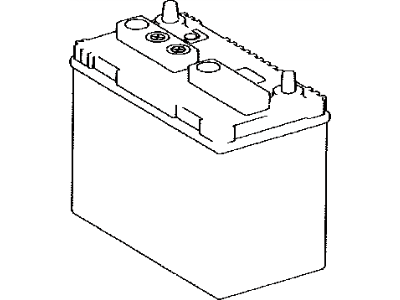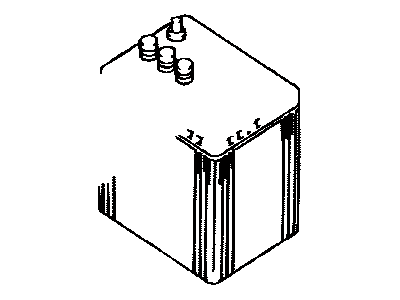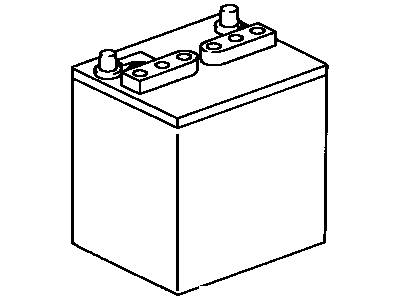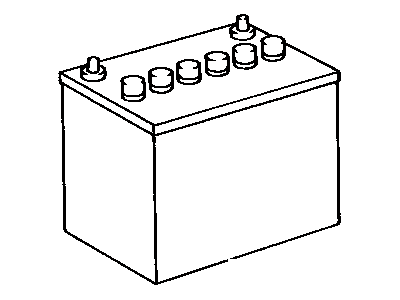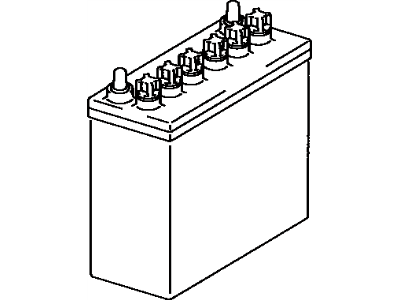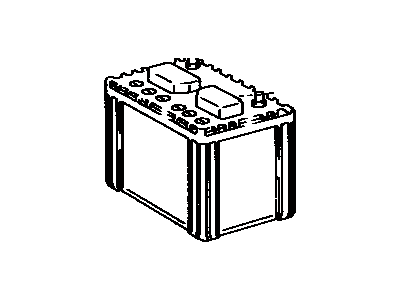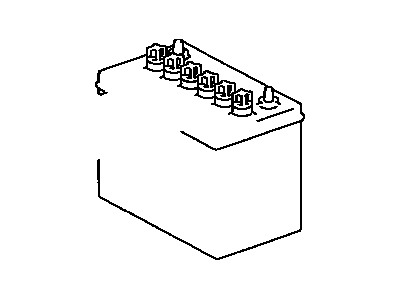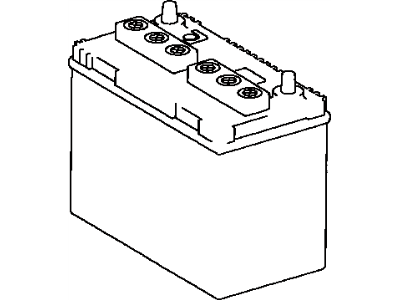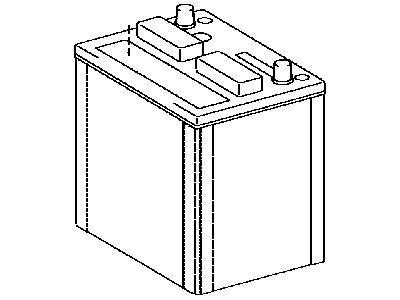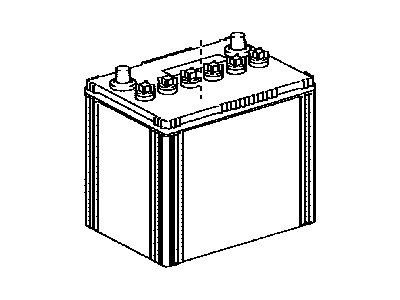Menu


My Garage
My Account
Cart
Genuine Toyota 4Runner Car Batteries
Auto Battery- Select Vehicle by Model
- Select Vehicle by VIN
Select Vehicle by Model
orMake
Model
Year
Select Vehicle by VIN
For the most accurate results, select vehicle by your VIN (Vehicle Identification Number).
23 Car Batteries found
Toyota 4Runner Battery, MAYDAY
Part Number: 86777-76020$235.82 MSRP: $338.14You Save: $102.32 (31%)Ships in 1-3 Business DaysADD TO CARTProduct Specifications- Replaced by: 86777-76040
- Warranty: This genuine part is guaranteed by Toyota's factory warranty.
Fits the following Vehicles:- 2012-2014 Toyota 4Runner | 4 Cyl 2.7L, 6 Cyl 4.0L | 1GRFE, 2TRFE; GRN280L-GKAGKA, GRN285L-GKAGKA, TRN280L-GKPGKA, TRN285L-GKPGKA
- Product Specifications
- Warranty: This genuine part is guaranteed by Toyota's factory warranty.
Fits the following Vehicles:- 2003-2009 Toyota 4Runner | Limited, SR5 | 6 Cyl 4.0L, 8 Cyl 4.7L | 1GRFE, 2UZFE; GRN210L-GKAGKA, GRN210L-GKAZKA, GRN210L-GKPGKA, GRN210L-GKPZKA, GRN215L-GKAGKA, GRN215L-GKAZKA, GRN215L-GKPGKA, GRN215L-GKPZKA, UZN210L-GKAGKA, UZN210L-GKAZKA, UZN215L-GKAGKA, UZN215L-GKAZKA
- Product Specifications
- Warranty: This genuine part is guaranteed by Toyota's factory warranty.
Fits the following Vehicles:- 1992-1995 Toyota 4Runner | DLX, SR5, STD | 4 Cyl 2.4L, 6 Cyl 3.0L | 22RE, 3VZE; RN101L-TRLDEA, RN101L-TRLDEAB, RN101L-TRLDEK, RN101L-TRMDEA, RN101L-TRMDEAB, RN101L-TRPDEA, RN101L-TRPDEAB, RN106L-TRLDEA, RN106L-TRLDEK, RN106L-TRMDEA, RN110L-CRLDEA, RN110L-CRLDEK, RN110L-CRMDEA, RN110L-CRMDEAB, RN110L-CRPDEA, RN120L-GKPSEA, RN121L-RKMSEK, RN121L-RKPSEK, RN130L-GJLSEA, RN130L-GJMSEA, RN130L-GJPSEA, RN130L-GKLSEA, RN130L-GKMSEA, RN130L-GKPSEA, RN131L-RJLSEK, RN131L-RJPSEK, RN131L-RKLSEK, RN131L-RKPSEK, RN80L-TRMDEA, RN80L-TRMDEAB, RN80L-TRMREA, RN80L-TRMREAB, RN80L-TRMREK, RN80L-TRSDEA, RN80L-TRSDEAB, RN85L-TRMDEA, RN85L-TRMDEK, RN85L-TRSDEA, RN85L-TRSDEK, RN90L-CRMDEA, RN90L-CRMDEAB, RN90L-CRMDEK, RN90L-CRSDEA, RN90L-CRSDEK, VZN100L-TRMDEA, VZN100L-TRMDEAB, VZN100L-TRMDEK, VZN105L-TRMDEA, VZN110L-CRMDEA, VZN110L-CRMDEAB, VZN110L-CRMDEK, VZN110L-CRMGEA, VZN110L-CRMGEK, VZN110L-CRPDEA, VZN110L-CRPDEAB, VZN110L-CRPDEK, VZN110L-CRPGEA, VZN120L-GKPGEA, VZN130L-GJMGEA, VZN130L-GJPGEA, VZN130L-GKMGEA, VZN130L-GKPGEA, VZN131L-RJMGEK, VZN131L-RJPGEK, VZN131L-RKMGEK, VZN131L-RKPGEK, VZN85L-THMDEA, VZN85L-THSDEA, VZN85L-TWMREA6, VZN85L-TWSREA6, VZN90L-CRMDEA, VZN90L-CRMDEK, VZN90L-CRMGEA, VZN90L-CRMGEK, VZN90L-CRPGEA, VZN90L-CRSDEA, VZN90L-CRSDEK, VZN95L-TWMREA6, VZN95L-TWSREA6, VZN95L-TWSREK6
- Product Specifications
- Manufacturer Note: 55D23R
- Warranty: This genuine part is guaranteed by Toyota's factory warranty.
Fits the following Vehicles:- 1992-1995 Toyota 4Runner | DLX, SR5, STD | 4 Cyl 2.4L, 6 Cyl 3.0L | 22RE, 3VZE; RN101L-TRLDEA, RN101L-TRLDEK, RN101L-TRMDEA, RN101L-TRPDEA, RN106L-TRLDEA, RN106L-TRLDEK, RN106L-TRMDEA, RN110L-CRLDEA, RN110L-CRLDEK, RN110L-CRMDEA, RN110L-CRPDEA, RN120L-GKPSEA, RN121L-RKMSEK, RN121L-RKPSEK, RN130L-GJLSEA, RN130L-GJMSEA, RN130L-GJPSEA, RN130L-GKLSEA, RN130L-GKMSEA, RN130L-GKPSEA, RN131L-RJLSEK, RN131L-RJPSEK, RN131L-RKLSEK, RN131L-RKPSEK, RN80L-TRMDEA, RN80L-TRMREA, RN80L-TRMREK, RN80L-TRSDEA, RN85L-TRMDEA, RN85L-TRMDEK, RN85L-TRSDEA, RN85L-TRSDEK, RN90L-CRMDEA, RN90L-CRMDEK, RN90L-CRSDEA, RN90L-CRSDEK, VZN100L-TRMDEA, VZN100L-TRMDEK, VZN105L-TRMDEA, VZN110L-CRMDEA, VZN110L-CRMDEK, VZN110L-CRMGEA, VZN110L-CRMGEK, VZN110L-CRPDEA, VZN110L-CRPDEK, VZN110L-CRPGEA, VZN120L-GKPGEA, VZN130L-GJMGEA, VZN130L-GJPGEA, VZN130L-GKMGEA, VZN130L-GKPGEA, VZN131L-RJMGEK, VZN131L-RJPGEK, VZN131L-RKMGEK, VZN131L-RKPGEK, VZN85L-THMDEA, VZN85L-THSDEA, VZN85L-TWMREA6, VZN85L-TWSREA6, VZN90L-CRMDEA, VZN90L-CRMDEK, VZN90L-CRMGEA, VZN90L-CRMGEK, VZN90L-CRPGEA, VZN90L-CRSDEA, VZN90L-CRSDEK, VZN95L-TWMREA6, VZN95L-TWSREA6, VZN95L-TWSREK6
- Product Specifications
- Warranty: This genuine part is guaranteed by Toyota's factory warranty.
Fits the following Vehicles:- 1984-1986 Toyota 4Runner | DLX, SDT, SR5, SR5 Turbo, STD | 4 Cyl 2.4L | 22R, 22REC, 22RTEC, 2L, 2LT; LN51L-KRA, LN51L-KRA3, LN56L-MDA3, LN56L-MDCA, LN56L-MDCA3, LN56L-MDCK, LN56L-MDCXA3, LN56L-MDK, LN56L-MDXA3, LN56L-MRK, LN65L-MDA, LN65L-MDA3, LN65L-MDCA3, LN65L-MDCK, LN65L-MDXA, LN65L-MDXA3, LN65L-MDXK, LN66L-MDCXK, RN50L-KRA, RN50L-KRK, RN50L-MRA, RN50L-MSEA, RN50L-MSEA3, RN50L-PRA, RN50L-SRA, RN55L-KDA3W, RN55L-KDEA3W, RN55L-KDEK3W, RN55L-KDK3W, RN55L-KRA3W, RN55L-KREA3W, RN55L-KRTEA3W, RN55L-MDA, RN55L-MDA3, RN55L-MDCA, RN55L-MDCA3, RN55L-MDCK, RN55L-MGCZA, RN55L-MGCZA3, RN55L-MRA, RN55L-MRHA, RN55L-MRHA3, RN55L-MRHEA, RN55L-MRHEK, RN55L-MRHK, RN55L-MRK, RN55L-MSCEA, RN55L-MSCEA3, RN55L-MSCEK, RN55L-MSEA, RN55L-MSEA3, RN55L-MSEK, RN55L-PDA, RN55L-PDA3, RN55L-PDCA, RN55L-PDCA3, RN55L-PDCK, RN55L-PDEA3W, RN55L-PDEK3W, RN55L-PDK, RN55L-PGCZA, RN55L-PGCZA3, RN55L-PGCZK, RN55L-PRA, RN55L-PRK, RN55L-PSCEA, RN55L-PSCEA3, RN55L-PSCEK, RN55L-PSEA3, RN55L-SDA, RN55L-SRA, RN55L-SREA3W, RN55L-SRHEA, RN55L-SRHEK, RN55L-SRK, RN55L-SRTEA3W, RN60LG-MDA, RN60LG-MDEA, RN60LG-MSA, RN60LG-MSEA, RN60LG-PDEA, RN60L-MDK, RN60L-MRA, RN60L-MRA3, RN60L-MSA, RN60L-MSA3, RN60L-MSEA, RN60L-MSEA3, RN60LV-MDA, RN60LV-MDEA, RN60LV-MSEK, RN60LV-MSK, RN60LV-PDEA, RN60LV-PSEK, RN61LG-MDEA, RN61LG-MSEA, RN61LG-PDEA, RN61LG-PGZA, RN61L-MBZA, RN61L-MBZA3, RN61L-MDK, RN61L-MRA, RN61L-MRA3, RN61L-MSEA, RN61L-MSEA3, RN61LV-MDEA, RN61LV-MSEA, RN61LV-MSEK, RN61LV-PDEA, RN61LV-PGZK, RN61LV-PSEA, RN61LV-PSEK, RN65L-MDA, RN65L-MDA3, RN65L-MDCA, RN65L-MDCA3, RN65L-MDK, RN65L-MSA3, RN65L-MSCA, RN65L-MSCA3, RN65L-MSCEA, RN65L-MSCEA3, RN65L-MSCEK, RN65L-MSCK, RN65L-MSEA3, RN65L-MSEK, RN65L-MSK, RN65L-PDCEA, RN65L-PDCEA3, RN65L-PDEA, RN65L-PDEA3, RN65L-PDEK, RN65L-PSCEK, RN66L-MDA, RN66L-MDA3, RN66L-MDCA, RN66L-MDCA3, RN66L-MDK, RN66L-MGCZA, RN66L-MGCZA3, RN66L-MGCZK, RN66L-MRA, RN66L-MSCEA, RN66L-MSCEA3, RN66L-MSCEK, RN66L-MSEA3, RN66L-MSEK, RN66L-PDCEA, RN66L-PDCEA3, RN66L-PDEA, RN66L-PDEA3, RN66L-PDEK, RN66L-PGCZA, RN66L-PGCZA3, RN66L-PGCZK, RN66L-PSCEA3, RN66L-PSCEK, RN70L-MDCA, RN70L-MDCA3, RN70L-MDCK, RN70L-MRCA, RN70L-MRCK, RN70L-SDCA, RN70L-SDCA3, RN70L-SDCK, RN70L-SRCA, RN70L-SRCK, RN75L-KRTEA3W, RN75L-SDTEA3W, RN75L-SDTEK3W
- Product Specifications
- Warranty: This genuine part is guaranteed by Toyota's factory warranty.
Fits the following Vehicles:- 1984-1991 Toyota 4Runner | DLX, SDT, SR5, SR5 Turbo, STD | 4 Cyl 2.4L, 6 Cyl 3.0L | 22R, 22RE, 22REC, 22RTEC, 2L, 2LT, 3VZE; LN51L-KRA, LN51L-KRA3, LN56L-MDA3, LN56L-MDCA, LN56L-MDCA3, LN56L-MDCK, LN56L-MDCXA3, LN56L-MDK, LN56L-MDXA3, LN56L-MRK, LN65L-MDA, LN65L-MDA3, LN65L-MDCA3, LN65L-MDCK, LN65L-MDXA, LN65L-MDXA3, LN65L-MDXK, LN66L-MDCXK, RN120L-GKPSEA, RN121L-RKMSEK, RN121L-RKPSEK, RN50L-KRA, RN50L-KRK, RN50L-LRA, RN50L-MRA, RN50L-MSEA, RN50L-MSEA3, RN50L-PRA, RN50L-SRA, RN50L-SREA, RN50L-TRA, RN55L-KDA3W, RN55L-KDEA3W, RN55L-KDEK3W, RN55L-KDK3W, RN55L-KRA3W, RN55L-KREA3W, RN55L-KRTEA3W, RN55L-LDA, RN55L-LDA3, RN55L-LRA, RN55L-MDA, RN55L-MDA3, RN55L-MDCA, RN55L-MDCA3, RN55L-MDCK, RN55L-MGCZA, RN55L-MGCZA3, RN55L-MRA, RN55L-MRHA, RN55L-MRHA3, RN55L-MRHEA, RN55L-MRHEK, RN55L-MRHK, RN55L-MRK, RN55L-MSCEA, RN55L-MSCEA3, RN55L-MSCEK, RN55L-MSCZA, RN55L-MSCZA3, RN55L-MSEA, RN55L-MSEA3, RN55L-MSEK, RN55L-PDA, RN55L-PDA3, RN55L-PDCA, RN55L-PDCA3, RN55L-PDCK, RN55L-PDEA3W, RN55L-PDEK3W, RN55L-PDK, RN55L-PGCZA, RN55L-PGCZA3, RN55L-PGCZK, RN55L-PRA, RN55L-PRK, RN55L-PSCEA, RN55L-PSCEA3, RN55L-PSCEK, RN55L-PSEA3, RN55L-SDA, RN55L-SDEA, RN55L-SDEA3, RN55L-SRA, RN55L-SREA, RN55L-SREA3W, RN55L-SREK, RN55L-SRHEA, RN55L-SRHEK, RN55L-SRK, RN55L-SRTEA3W, RN60LG-MDA, RN60LG-MDEA, RN60LG-MSA, RN60LG-MSEA, RN60LG-PDEA, RN60L-MDK, RN60L-MRA, RN60L-MRA3, RN60L-MSA, RN60L-MSA3, RN60L-MSEA, RN60L-MSEA3, RN60LV-MDA, RN60LV-MDEA, RN60LV-MSEK, RN60LV-MSK, RN60LV-PDEA, RN60LV-PSEK, RN61LG-MDEA, RN61LG-MSEA, RN61LG-PDEA, RN61LG-PGZA, RN61LG-PSEA, RN61L-MBZA, RN61L-MBZA3, RN61L-MDK, RN61L-MRA, RN61L-MRA3, RN61L-MREA, RN61L-MREA3, RN61L-MREK, RN61L-MSEA, RN61L-MSEA3, RN61LV-MDEA, RN61LV-MDEK, RN61LV-MSEA, RN61LV-MSEK, RN61LV-PDEA, RN61LV-PDEK, RN61LV-PGZK, RN61LV-PSEA, RN61LV-PSEK, RN65L-MDA, RN65L-MDA3, RN65L-MDCA, RN65L-MDCA3, RN65L-MDK, RN65L-MSA3, RN65L-MSCA, RN65L-MSCA3, RN65L-MSCEA, RN65L-MSCEA3, RN65L-MSCEK, RN65L-MSCK, RN65L-MSEA3, RN65L-MSEK, RN65L-MSK, RN65L-PDCEA, RN65L-PDCEA3, RN65L-PDEA, RN65L-PDEA3, RN65L-PDEK, RN65L-PSCEK, RN66L-MDA, RN66L-MDA3, RN66L-MDCA, RN66L-MDCA3, RN66L-MDCEA, RN66L-MDCEA3, RN66L-MDCEK, RN66L-MDEA, RN66L-MDEA3, RN66L-MDEK, RN66L-MDK, RN66L-MGCZA, RN66L-MGCZA3, RN66L-MGCZK, RN66L-MRA, RN66L-MSCEA, RN66L-MSCEA3, RN66L-MSCEK, RN66L-MSEA3, RN66L-MSEK, RN66L-PDCEA, RN66L-PDCEA3, RN66L-PDEA, RN66L-PDEA3, RN66L-PDEK, RN66L-PGCZA, RN66L-PGCZA3, RN66L-PGCZK, RN66L-PSCEA3, RN66L-PSCEK, RN70L-LDCA3, RN70L-LRCA, RN70L-LRCA3, RN70L-MDCA, RN70L-MDCA3, RN70L-MDCK, RN70L-MRCA, RN70L-MRCA3, RN70L-MRCK, RN70L-SDCA, RN70L-SDCA3, RN70L-SDCEA3, RN70L-SDCK, RN70L-SRCA, RN70L-SRCEA, RN70L-SRCEA3, RN70L-SRCEK, RN70L-SRCK, RN75L-KRTEA3W, RN75L-PDTEA3W, RN75L-SDTEA3W, RN75L-SDTEK3W, RN80L-TRKREA, RN80L-TRKRSA, RN80L-TRKRSA3, RN80L-TRLDSA, RN80L-TRLDSA3, RN80L-TRMDEA, RN80L-TRMDEA3, RN80L-TRMREA, RN80L-TRMREK, RN80L-TRMRSK, RN80L-TRSDEA, RN80L-TRSDEA3, RN80L-TRTRSA, RN80L-TRTRSA3, RN85L-TRLDSA, RN85L-TRLDSA3, RN85L-TRMDEA, RN85L-TRMDEA3, RN85L-TRMDEK, RN85L-TRMDSK, RN85L-TRMSEA, RN85L-TRMSEA3, RN85L-TRSDEA, RN85L-TRSDEA3, RN85L-TRSDEK, RN85L-TRSSEA, RN85L-TRSSEA3, RN90L-CRLDSA, RN90L-CRLDSA3, RN90L-CRMDEA, RN90L-CRMDEA3, RN90L-CRMDEK, RN90L-CRMDSK, RN90L-CRMSEA, RN90L-CRMSEA3, RN90L-CRSDEA, RN90L-CRSDEA3, RN90L-CRSDEK, RN90L-CRSSEA, RN90L-CRSSEA3, VZN120L-GKPGEA, VZN61LG-MSEA, VZN61LG-PSEA, VZN61L-MBEA, VZN61L-MBEA3, VZN61L-MSEA, VZN61L-MSEA3, VZN61LV-MDEA, VZN61LV-MSEA, VZN61LV-MSEK, VZN61LV-PDEA, VZN61LV-PSEA, VZN61LV-PSEK, VZN66L-MDCEA3, VZN66L-MDCEK, VZN66L-MDEA3, VZN66L-MDEK, VZN66L-MSCEA, VZN66L-MSCEA3, VZN66L-MSCEK, VZN66L-PDCEA3, VZN66L-PDEA3, VZN66L-PDEK, VZN66L-PSCEA3, VZN66L-PSCEK, VZN85L-THMDEA, VZN85L-THMDEA3, VZN85L-THSDEA, VZN85L-THSDEA3, VZN85L-TRMDEA, VZN85L-TRMDEA3, VZN85L-TRMDEK, VZN85L-TRMREA6, VZN85L-TRSDEA, VZN85L-TRSDEA3, VZN85L-TRSDEK, VZN85L-TRSREA6, VZN85L-TWMREA6, VZN85L-TWSREA6, VZN90L-CRMDEA, VZN90L-CRMDEA3, VZN90L-CRMDEK, VZN90L-CRMGEA, VZN90L-CRMGEA3, VZN90L-CRMGEK, VZN90L-CRPGEA, VZN90L-CRPGEA3, VZN90L-CRSDEA, VZN90L-CRSDEA3, VZN90L-CRSDEK, VZN95L-TWMREA6, VZN95L-TWSREA6, VZN95L-TWSREK6
- Product Specifications
- Warranty: This genuine part is guaranteed by Toyota's factory warranty.
Fits the following Vehicles:- 1984-1995 Toyota 4Runner | DLX, SDT, SR5, SR5 Turbo, STD | 4 Cyl 2.4L, 6 Cyl 3.0L | 22R, 22RE, 22REC, 22RTEC, 2L, 2LT, 3VZE; LN51L-KRA, LN51L-KRA3, LN56L-MDA3, LN56L-MDCA, LN56L-MDCA3, LN56L-MDCK, LN56L-MDCXA3, LN56L-MDK, LN56L-MDXA3, LN56L-MRK, LN65L-MDA, LN65L-MDA3, LN65L-MDCA3, LN65L-MDCK, LN65L-MDXA, LN65L-MDXA3, LN65L-MDXK, LN66L-MDCXK, RN101L-TRLDEA, RN101L-TRLDEK, RN101L-TRLSEA, RN101L-TRLSEA3, RN101L-TRMDEA, RN101L-TRMDEA3, RN101L-TRMDEK, RN101L-TRMSEA, RN101L-TRMSEA3, RN101L-TRPDEA, RN106L-TRLDEA, RN106L-TRLDEK, RN106L-TRMDEA, RN106L-TRMDEA3, RN106L-TRMDEK, RN106L-TRPDEA, RN106L-TRPDEA3, RN106L-TRPDEK, RN110L-CRLDEA, RN110L-CRLDEK, RN110L-CRLSEA, RN110L-CRLSEA3, RN110L-CRMDEA, RN110L-CRMDEA3, RN110L-CRMDEK, RN110L-CRMSEA, RN110L-CRMSEA3, RN110L-CRPDEA, RN110L-CRPDEA3, RN110L-CRPSEA, RN110L-CRPSEA3, RN120L-GKPSEA, RN121L-RKMSEK, RN121L-RKPSEK, RN130L-GJLSEA, RN130L-GJMSEA, RN130L-GJPSEA, RN130L-GKLSEA, RN130L-GKMSEA, RN130L-GKPSEA, RN131L-RJLSEK, RN131L-RJMSEK, RN131L-RJPSEK, RN131L-RKLSEK, RN131L-RKMSEK, RN131L-RKPSEK, RN50L-KRA, RN50L-KRK, RN50L-LRA, RN50L-MRA, RN50L-MSEA, RN50L-MSEA3, RN50L-PRA, RN50L-SRA, RN50L-SREA, RN50L-TRA, RN55L-KDA3W, RN55L-KDEA3W, RN55L-KDEK3W, RN55L-KDK3W, RN55L-KRA3W, RN55L-KREA3W, RN55L-KRTEA3W, RN55L-LDA, RN55L-LDA3, RN55L-LRA, RN55L-MDA, RN55L-MDA3, RN55L-MDCA, RN55L-MDCA3, RN55L-MDCK, RN55L-MGCZA, RN55L-MGCZA3, RN55L-MRA, RN55L-MRHA, RN55L-MRHA3, RN55L-MRHEA, RN55L-MRHEK, RN55L-MRHK, RN55L-MRK, RN55L-MSCEA, RN55L-MSCEA3, RN55L-MSCEK, RN55L-MSCZA, RN55L-MSCZA3, RN55L-MSEA, RN55L-MSEA3, RN55L-MSEK, RN55L-PDA, RN55L-PDA3, RN55L-PDCA, RN55L-PDCA3, RN55L-PDCK, RN55L-PDEA3W, RN55L-PDEK3W, RN55L-PDK, RN55L-PGCZA, RN55L-PGCZA3, RN55L-PGCZK, RN55L-PRA, RN55L-PRK, RN55L-PSCEA, RN55L-PSCEA3, RN55L-PSCEK, RN55L-PSEA3, RN55L-SDA, RN55L-SDEA, RN55L-SDEA3, RN55L-SRA, RN55L-SREA, RN55L-SREA3W, RN55L-SREK, RN55L-SRHEA, RN55L-SRHEK, RN55L-SRK, RN55L-SRTEA3W, RN60LG-MDA, RN60LG-MDEA, RN60LG-MSA, RN60LG-MSEA, RN60LG-PDEA, RN60L-MDK, RN60L-MRA, RN60L-MRA3, RN60L-MSA, RN60L-MSA3, RN60L-MSEA, RN60L-MSEA3, RN60LV-MDA, RN60LV-MDEA, RN60LV-MSEK, RN60LV-MSK, RN60LV-PDEA, RN60LV-PSEK, RN61LG-MDEA, RN61LG-MSEA, RN61LG-PDEA, RN61LG-PGZA, RN61LG-PSEA, RN61L-MBZA, RN61L-MBZA3, RN61L-MDK, RN61L-MRA, RN61L-MRA3, RN61L-MREA, RN61L-MREA3, RN61L-MREK, RN61L-MSEA, RN61L-MSEA3, RN61LV-MDEA, RN61LV-MDEK, RN61LV-MSEA, RN61LV-MSEK, RN61LV-PDEA, RN61LV-PDEK, RN61LV-PGZK, RN61LV-PSEA, RN61LV-PSEK, RN65L-MDA, RN65L-MDA3, RN65L-MDCA, RN65L-MDCA3, RN65L-MDK, RN65L-MSA3, RN65L-MSCA, RN65L-MSCA3, RN65L-MSCEA, RN65L-MSCEA3, RN65L-MSCEK, RN65L-MSCK, RN65L-MSEA3, RN65L-MSEK, RN65L-MSK, RN65L-PDCEA, RN65L-PDCEA3, RN65L-PDEA, RN65L-PDEA3, RN65L-PDEK, RN65L-PSCEK, RN66L-MDA, RN66L-MDA3, RN66L-MDCA, RN66L-MDCA3, RN66L-MDCEA, RN66L-MDCEA3, RN66L-MDCEK, RN66L-MDEA, RN66L-MDEA3, RN66L-MDEK, RN66L-MDK, RN66L-MGCZA, RN66L-MGCZA3, RN66L-MGCZK, RN66L-MRA, RN66L-MSCEA, RN66L-MSCEA3, RN66L-MSCEK, RN66L-MSEA3, RN66L-MSEK, RN66L-PDCEA, RN66L-PDCEA3, RN66L-PDEA, RN66L-PDEA3, RN66L-PDEK, RN66L-PGCZA, RN66L-PGCZA3, RN66L-PGCZK, RN66L-PSCEA3, RN66L-PSCEK, RN70L-LDCA3, RN70L-LRCA, RN70L-LRCA3, RN70L-MDCA, RN70L-MDCA3, RN70L-MDCK, RN70L-MRCA, RN70L-MRCA3, RN70L-MRCK, RN70L-SDCA, RN70L-SDCA3, RN70L-SDCEA3, RN70L-SDCK, RN70L-SRCA, RN70L-SRCEA, RN70L-SRCEA3, RN70L-SRCEK, RN70L-SRCK, RN75L-KRTEA3W, RN75L-PDTEA3W, RN75L-SDTEA3W, RN75L-SDTEK3W, RN80L-TRKREA, RN80L-TRKRSA, RN80L-TRKRSA3, RN80L-TRLDSA, RN80L-TRLDSA3, RN80L-TRMDEA, RN80L-TRMDEA3, RN80L-TRMREA, RN80L-TRMREK, RN80L-TRMRSK, RN80L-TRSDEA, RN80L-TRSDEA3, RN80L-TRTRSA, RN80L-TRTRSA3, RN85L-TRLDSA, RN85L-TRLDSA3, RN85L-TRMDEA, RN85L-TRMDEA3, RN85L-TRMDEK, RN85L-TRMDSK, RN85L-TRMSEA, RN85L-TRMSEA3, RN85L-TRSDEA, RN85L-TRSDEA3, RN85L-TRSDEK, RN85L-TRSSEA, RN85L-TRSSEA3, RN90L-CRLDSA, RN90L-CRLDSA3, RN90L-CRMDEA, RN90L-CRMDEA3, RN90L-CRMDEK, RN90L-CRMDSK, RN90L-CRMSEA, RN90L-CRMSEA3, RN90L-CRSDEA, RN90L-CRSDEA3, RN90L-CRSDEK, RN90L-CRSSEA, RN90L-CRSSEA3, VZN100L-TRMDEA, VZN100L-TRMDEA3, VZN100L-TRMDEK, VZN100L-TRMGEA, VZN100L-TRMGEA3, VZN105L-TRMDEA, VZN105L-TRMDEA3, VZN105L-TRMDEK, VZN105L-TRPDEA, VZN105L-TRPDEA3, VZN110L-CRMDEA, VZN110L-CRMDEA3, VZN110L-CRMDEK, VZN110L-CRMGEA, VZN110L-CRMGEA3, VZN110L-CRMGEK, VZN110L-CRPDEA, VZN110L-CRPDEA3, VZN110L-CRPDEK, VZN110L-CRPGEA, VZN110L-CRPGEA3, VZN120L-GKPGEA, VZN130L-GJMGEA, VZN130L-GJPGEA, VZN130L-GKMGEA, VZN130L-GKPGEA, VZN131L-RJMGEK, VZN131L-RJPGEK, VZN131L-RKMGEK, VZN131L-RKPGEK, VZN61LG-MSEA, VZN61LG-PSEA, VZN61L-MBEA, VZN61L-MBEA3, VZN61L-MSEA, VZN61L-MSEA3, VZN61LV-MDEA, VZN61LV-MSEA, VZN61LV-MSEK, VZN61LV-PDEA, VZN61LV-PSEA, VZN61LV-PSEK, VZN66L-MDCEA3, VZN66L-MDCEK, VZN66L-MDEA3, VZN66L-MDEK, VZN66L-MSCEA, VZN66L-MSCEA3, VZN66L-MSCEK, VZN66L-PDCEA3, VZN66L-PDEA3, VZN66L-PDEK, VZN66L-PSCEA3, VZN66L-PSCEK, VZN85L-THMDEA, VZN85L-THMDEA3, VZN85L-THSDEA, VZN85L-THSDEA3, VZN85L-TRMDEA, VZN85L-TRMDEA3, VZN85L-TRMDEK, VZN85L-TRMREA6, VZN85L-TRSDEA, VZN85L-TRSDEA3, VZN85L-TRSDEK, VZN85L-TRSREA6, VZN85L-TWMREA6, VZN85L-TWSREA6, VZN90L-CRMDEA, VZN90L-CRMDEA3, VZN90L-CRMDEK, VZN90L-CRMGEA, VZN90L-CRMGEA3, VZN90L-CRMGEK, VZN90L-CRPGEA, VZN90L-CRPGEA3, VZN90L-CRSDEA, VZN90L-CRSDEA3, VZN90L-CRSDEK, VZN95L-TWMREA6, VZN95L-TWSREA6, VZN95L-TWSREK6
- Product Specifications
- Warranty: This genuine part is guaranteed by Toyota's factory warranty.
Fits the following Vehicles:- 1984-1991 Toyota 4Runner | DLX, SDT, SR5, SR5 Turbo, STD | 4 Cyl 2.4L, 6 Cyl 3.0L | 22R, 22RE, 22REC, 22RTEC, 2L, 2LT, 3VZE; LN51L-KRA, LN51L-KRA3, LN56L-MDA3, LN56L-MDCA, LN56L-MDCA3, LN56L-MDCK, LN56L-MDCXA3, LN56L-MDK, LN56L-MDXA3, LN56L-MRK, LN65L-MDA, LN65L-MDA3, LN65L-MDCA3, LN65L-MDCK, LN65L-MDXA, LN65L-MDXA3, LN65L-MDXK, LN66L-MDCXK, RN120L-GKPSEA, RN121L-RKMSEK, RN121L-RKPSEK, RN50L-KRA, RN50L-KRK, RN50L-LRA, RN50L-MRA, RN50L-MSEA, RN50L-MSEA3, RN50L-PRA, RN50L-SRA, RN50L-SREA, RN50L-TRA, RN55L-KDA3W, RN55L-KDEA3W, RN55L-KDEK3W, RN55L-KDK3W, RN55L-KRA3W, RN55L-KREA3W, RN55L-KRTEA3W, RN55L-LDA, RN55L-LDA3, RN55L-LRA, RN55L-MDA, RN55L-MDA3, RN55L-MDCA, RN55L-MDCA3, RN55L-MDCK, RN55L-MGCZA, RN55L-MGCZA3, RN55L-MRA, RN55L-MRHA, RN55L-MRHA3, RN55L-MRHEA, RN55L-MRHEK, RN55L-MRHK, RN55L-MRK, RN55L-MSCEA, RN55L-MSCEA3, RN55L-MSCEK, RN55L-MSCZA, RN55L-MSCZA3, RN55L-MSEA, RN55L-MSEA3, RN55L-MSEK, RN55L-PDA, RN55L-PDA3, RN55L-PDCA, RN55L-PDCA3, RN55L-PDCK, RN55L-PDEA3W, RN55L-PDEK3W, RN55L-PDK, RN55L-PGCZA, RN55L-PGCZA3, RN55L-PGCZK, RN55L-PRA, RN55L-PRK, RN55L-PSCEA, RN55L-PSCEA3, RN55L-PSCEK, RN55L-PSEA3, RN55L-SDA, RN55L-SDEA, RN55L-SDEA3, RN55L-SRA, RN55L-SREA, RN55L-SREA3W, RN55L-SREK, RN55L-SRHEA, RN55L-SRHEK, RN55L-SRK, RN55L-SRTEA3W, RN60LG-MDA, RN60LG-MDEA, RN60LG-MSA, RN60LG-MSEA, RN60LG-PDEA, RN60L-MDK, RN60L-MRA, RN60L-MRA3, RN60L-MSA, RN60L-MSA3, RN60L-MSEA, RN60L-MSEA3, RN60LV-MDA, RN60LV-MDEA, RN60LV-MSEK, RN60LV-MSK, RN60LV-PDEA, RN60LV-PSEK, RN61LG-MDEA, RN61LG-MSEA, RN61LG-PDEA, RN61LG-PGZA, RN61LG-PSEA, RN61L-MBZA, RN61L-MBZA3, RN61L-MDK, RN61L-MRA, RN61L-MRA3, RN61L-MREA, RN61L-MREA3, RN61L-MREK, RN61L-MSEA, RN61L-MSEA3, RN61LV-MDEA, RN61LV-MDEK, RN61LV-MSEA, RN61LV-MSEK, RN61LV-PDEA, RN61LV-PDEK, RN61LV-PGZK, RN61LV-PSEA, RN61LV-PSEK, RN65L-MDA, RN65L-MDA3, RN65L-MDCA, RN65L-MDCA3, RN65L-MDK, RN65L-MSA3, RN65L-MSCA, RN65L-MSCA3, RN65L-MSCEA, RN65L-MSCEA3, RN65L-MSCEK, RN65L-MSCK, RN65L-MSEA3, RN65L-MSEK, RN65L-MSK, RN65L-PDCEA, RN65L-PDCEA3, RN65L-PDEA, RN65L-PDEA3, RN65L-PDEK, RN65L-PSCEK, RN66L-MDA, RN66L-MDA3, RN66L-MDCA, RN66L-MDCA3, RN66L-MDCEA, RN66L-MDCEA3, RN66L-MDCEK, RN66L-MDEA, RN66L-MDEA3, RN66L-MDEK, RN66L-MDK, RN66L-MGCZA, RN66L-MGCZA3, RN66L-MGCZK, RN66L-MRA, RN66L-MSCEA, RN66L-MSCEA3, RN66L-MSCEK, RN66L-MSEA3, RN66L-MSEK, RN66L-PDCEA, RN66L-PDCEA3, RN66L-PDEA, RN66L-PDEA3, RN66L-PDEK, RN66L-PGCZA, RN66L-PGCZA3, RN66L-PGCZK, RN66L-PSCEA3, RN66L-PSCEK, RN70L-LDCA3, RN70L-LRCA, RN70L-LRCA3, RN70L-MDCA, RN70L-MDCA3, RN70L-MDCK, RN70L-MRCA, RN70L-MRCA3, RN70L-MRCK, RN70L-SDCA, RN70L-SDCA3, RN70L-SDCEA3, RN70L-SDCK, RN70L-SRCA, RN70L-SRCEA, RN70L-SRCEA3, RN70L-SRCEK, RN70L-SRCK, RN75L-KRTEA3W, RN75L-PDTEA3W, RN75L-SDTEA3W, RN75L-SDTEK3W, RN80L-TRKREA, RN80L-TRKRSA, RN80L-TRKRSA3, RN80L-TRLDSA, RN80L-TRLDSA3, RN80L-TRMDEA, RN80L-TRMDEA3, RN80L-TRMREA, RN80L-TRMREK, RN80L-TRMRSK, RN80L-TRSDEA, RN80L-TRSDEA3, RN80L-TRTRSA, RN80L-TRTRSA3, RN85L-TRLDSA, RN85L-TRLDSA3, RN85L-TRMDEA, RN85L-TRMDEA3, RN85L-TRMDEK, RN85L-TRMDSK, RN85L-TRMSEA, RN85L-TRMSEA3, RN85L-TRSDEA, RN85L-TRSDEA3, RN85L-TRSDEK, RN85L-TRSSEA, RN85L-TRSSEA3, RN90L-CRLDSA, RN90L-CRLDSA3, RN90L-CRMDEA, RN90L-CRMDEA3, RN90L-CRMDEK, RN90L-CRMDSK, RN90L-CRMSEA, RN90L-CRMSEA3, RN90L-CRSDEA, RN90L-CRSDEA3, RN90L-CRSDEK, RN90L-CRSSEA, RN90L-CRSSEA3, VZN120L-GKPGEA, VZN61LG-MSEA, VZN61LG-PSEA, VZN61L-MBEA, VZN61L-MBEA3, VZN61L-MSEA, VZN61L-MSEA3, VZN61LV-MDEA, VZN61LV-MSEA, VZN61LV-MSEK, VZN61LV-PDEA, VZN61LV-PSEA, VZN61LV-PSEK, VZN66L-MDCEA3, VZN66L-MDCEK, VZN66L-MDEA3, VZN66L-MDEK, VZN66L-MSCEA, VZN66L-MSCEA3, VZN66L-MSCEK, VZN66L-PDCEA3, VZN66L-PDEA3, VZN66L-PDEK, VZN66L-PSCEA3, VZN66L-PSCEK, VZN85L-THMDEA, VZN85L-THMDEA3, VZN85L-THSDEA, VZN85L-THSDEA3, VZN85L-TRMDEA, VZN85L-TRMDEA3, VZN85L-TRMDEK, VZN85L-TRMREA6, VZN85L-TRSDEA, VZN85L-TRSDEA3, VZN85L-TRSDEK, VZN85L-TRSREA6, VZN85L-TWMREA6, VZN85L-TWSREA6, VZN90L-CRMDEA, VZN90L-CRMDEA3, VZN90L-CRMDEK, VZN90L-CRMGEA, VZN90L-CRMGEA3, VZN90L-CRMGEK, VZN90L-CRPGEA, VZN90L-CRPGEA3, VZN90L-CRSDEA, VZN90L-CRSDEA3, VZN90L-CRSDEK, VZN95L-TWMREA6, VZN95L-TWSREA6, VZN95L-TWSREK6
- Product Specifications
- Warranty: This genuine part is guaranteed by Toyota's factory warranty.
Fits the following Vehicles:- 1996-1997 Toyota 4Runner | LULI, SR5B, SR5V | 4 Cyl 2.7L, 6 Cyl 3.4L | 3RZFE, 5VZFE; RZN180L-GKMSKA, RZN180L-GKPSKA, RZN185L-GKMSKA, RZN185L-GKPSKA, VZN180L-GKPGKA, VZN180L-GKPZKA, VZN185L-GKMGKA, VZN185L-GKPGKA, VZN185L-GKPZKA
- Product Specifications
- Warranty: This genuine part is guaranteed by Toyota's factory warranty.
Fits the following Vehicles:- 1996-2002 Toyota 4Runner | LULI, SR5B, SR5V | 4 Cyl 2.7L, 6 Cyl 3.4L | 3RZFE, 5VZFE; RZN180L-GKMSKA, RZN180L-GKPSKA, RZN185L-GKMSKA, RZN185L-GKPSKA, VZN180L-GKPGKA, VZN180L-GKPSKA, VZN180L-GKPZKA, VZN185L-GKMGKA, VZN185L-GKPGKA, VZN185L-GKPSKA, VZN185L-GKPZKA
- Product Specifications
- Manufacturer Note: 95D31L
- Warranty: This genuine part is guaranteed by Toyota's factory warranty.
Fits the following Vehicles:- 1996-1997 Toyota 4Runner | LULI, SR5B, SR5V | 4 Cyl 2.7L, 6 Cyl 3.4L | 3RZFE, 5VZFE; RZN180L-GKMSKA, RZN180L-GKPSKA, RZN185L-GKMSKA, RZN185L-GKPSKA, VZN180L-GKPGKA, VZN180L-GKPZKA, VZN185L-GKMGKA, VZN185L-GKPGKA, VZN185L-GKPZKA
- Product Specifications
- Manufacturer Note: 95D31L
- Warranty: This genuine part is guaranteed by Toyota's factory warranty.
Fits the following Vehicles:- 1996-2001 Toyota 4Runner | LULI, SR5B, SR5V | 4 Cyl 2.7L, 6 Cyl 3.4L | 3RZFE, 5VZFE; RZN180L-GKMSKA, RZN180L-GKPSKA, RZN185L-GKMSKA, RZN185L-GKPSKA, VZN180L-GKPGKA, VZN180L-GKPSKA, VZN180L-GKPZKA, VZN185L-GKMGKA, VZN185L-GKPGKA, VZN185L-GKPSKA, VZN185L-GKPZKA
- Product Specifications
- Warranty: This genuine part is guaranteed by Toyota's factory warranty.
Fits the following Vehicles:- 2010-2024 Toyota 4Runner | 4 Cyl 2.7L, 6 Cyl 4.0L | 1GRFE, 2TRFE; GRN280L-GKAGKA, GRN285L-GKAGKA, TRN280L-GKPGKA, TRN285L-GKPGKA
- Product Specifications
- Warranty: This genuine part is guaranteed by Toyota's factory warranty.
Fits the following Vehicles:- 1984-1986 Toyota 4Runner | DLX, SDT, SR5, SR5 Turbo, STD | 4 Cyl 2.4L | 22R, 22REC, 22RTEC, 2L, 2LT; LN51L-KRA, LN51L-KRA3, LN56L-MDA3, LN56L-MDCA, LN56L-MDCA3, LN56L-MDCK, LN56L-MDCXA3, LN56L-MDK, LN56L-MDXA3, LN56L-MRK, LN65L-MDA, LN65L-MDA3, LN65L-MDCA3, LN65L-MDCK, LN65L-MDXA, LN65L-MDXA3, LN65L-MDXK, LN66L-MDCXK, RN50L-KRA, RN50L-KRK, RN50L-MRA, RN50L-MSEA, RN50L-MSEA3, RN50L-PRA, RN50L-SRA, RN55L-KDA3W, RN55L-KDEA3W, RN55L-KDEK3W, RN55L-KDK3W, RN55L-KRA3W, RN55L-KREA3W, RN55L-KRTEA3W, RN55L-MDA, RN55L-MDA3, RN55L-MDCA, RN55L-MDCA3, RN55L-MDCK, RN55L-MGCZA, RN55L-MGCZA3, RN55L-MRA, RN55L-MRHA, RN55L-MRHA3, RN55L-MRHEA, RN55L-MRHEK, RN55L-MRHK, RN55L-MRK, RN55L-MSCEA, RN55L-MSCEA3, RN55L-MSCEK, RN55L-MSEA, RN55L-MSEA3, RN55L-MSEK, RN55L-PDA, RN55L-PDA3, RN55L-PDCA, RN55L-PDCA3, RN55L-PDCK, RN55L-PDEA3W, RN55L-PDEK3W, RN55L-PDK, RN55L-PGCZA, RN55L-PGCZA3, RN55L-PGCZK, RN55L-PRA, RN55L-PRK, RN55L-PSCEA, RN55L-PSCEA3, RN55L-PSCEK, RN55L-PSEA3, RN55L-SDA, RN55L-SRA, RN55L-SREA3W, RN55L-SRHEA, RN55L-SRHEK, RN55L-SRK, RN55L-SRTEA3W, RN60LG-MDA, RN60LG-MDEA, RN60LG-MSA, RN60LG-MSEA, RN60LG-PDEA, RN60L-MDK, RN60L-MRA, RN60L-MRA3, RN60L-MSA, RN60L-MSA3, RN60L-MSEA, RN60L-MSEA3, RN60LV-MDA, RN60LV-MDEA, RN60LV-MSEK, RN60LV-MSK, RN60LV-PDEA, RN60LV-PSEK, RN61LG-MDEA, RN61LG-MSEA, RN61LG-PDEA, RN61LG-PGZA, RN61L-MBZA, RN61L-MBZA3, RN61L-MDK, RN61L-MRA, RN61L-MRA3, RN61L-MSEA, RN61L-MSEA3, RN61LV-MDEA, RN61LV-MSEA, RN61LV-MSEK, RN61LV-PDEA, RN61LV-PGZK, RN61LV-PSEA, RN61LV-PSEK, RN65L-MDA, RN65L-MDA3, RN65L-MDCA, RN65L-MDCA3, RN65L-MDK, RN65L-MSA3, RN65L-MSCA, RN65L-MSCA3, RN65L-MSCEA, RN65L-MSCEA3, RN65L-MSCEK, RN65L-MSCK, RN65L-MSEA3, RN65L-MSEK, RN65L-MSK, RN65L-PDCEA, RN65L-PDCEA3, RN65L-PDEA, RN65L-PDEA3, RN65L-PDEK, RN65L-PSCEK, RN66L-MDA, RN66L-MDA3, RN66L-MDCA, RN66L-MDCA3, RN66L-MDK, RN66L-MGCZA, RN66L-MGCZA3, RN66L-MGCZK, RN66L-MRA, RN66L-MSCEA, RN66L-MSCEA3, RN66L-MSCEK, RN66L-MSEA3, RN66L-MSEK, RN66L-PDCEA, RN66L-PDCEA3, RN66L-PDEA, RN66L-PDEA3, RN66L-PDEK, RN66L-PGCZA, RN66L-PGCZA3, RN66L-PGCZK, RN66L-PSCEA3, RN66L-PSCEK, RN70L-MDCA, RN70L-MDCA3, RN70L-MDCK, RN70L-MRCA, RN70L-MRCK, RN70L-SDCA, RN70L-SDCA3, RN70L-SDCK, RN70L-SRCA, RN70L-SRCK, RN75L-KRTEA3W, RN75L-SDTEA3W, RN75L-SDTEK3W
- Product Specifications
- Warranty: This genuine part is guaranteed by Toyota's factory warranty.
Fits the following Vehicles:- 1984-1986 Toyota 4Runner | DLX, SDT, SR5, SR5 Turbo, STD | 4 Cyl 2.4L | 22R, 22REC, 22RTEC, 2L, 2LT; LN51L-KRA, LN51L-KRA3, LN56L-MDA3, LN56L-MDCA, LN56L-MDCA3, LN56L-MDCK, LN56L-MDCXA3, LN56L-MDK, LN56L-MDXA3, LN56L-MRK, LN65L-MDA, LN65L-MDA3, LN65L-MDCA3, LN65L-MDCK, LN65L-MDXA, LN65L-MDXA3, LN65L-MDXK, LN66L-MDCXK, RN50L-KRA, RN50L-KRK, RN50L-MRA, RN50L-MSEA, RN50L-MSEA3, RN50L-PRA, RN50L-SRA, RN55L-KDA3W, RN55L-KDEA3W, RN55L-KDEK3W, RN55L-KDK3W, RN55L-KRA3W, RN55L-KREA3W, RN55L-KRTEA3W, RN55L-MDA, RN55L-MDA3, RN55L-MDCA, RN55L-MDCA3, RN55L-MDCK, RN55L-MGCZA, RN55L-MGCZA3, RN55L-MRA, RN55L-MRHA, RN55L-MRHA3, RN55L-MRHEA, RN55L-MRHEK, RN55L-MRHK, RN55L-MRK, RN55L-MSCEA, RN55L-MSCEA3, RN55L-MSCEK, RN55L-MSEA, RN55L-MSEA3, RN55L-MSEK, RN55L-PDA, RN55L-PDA3, RN55L-PDCA, RN55L-PDCA3, RN55L-PDCK, RN55L-PDEA3W, RN55L-PDEK3W, RN55L-PDK, RN55L-PGCZA, RN55L-PGCZA3, RN55L-PGCZK, RN55L-PRA, RN55L-PRK, RN55L-PSCEA, RN55L-PSCEA3, RN55L-PSCEK, RN55L-PSEA3, RN55L-SDA, RN55L-SRA, RN55L-SREA3W, RN55L-SRHEA, RN55L-SRHEK, RN55L-SRK, RN55L-SRTEA3W, RN60LG-MDA, RN60LG-MDEA, RN60LG-MSA, RN60LG-MSEA, RN60LG-PDEA, RN60L-MDK, RN60L-MRA, RN60L-MRA3, RN60L-MSA, RN60L-MSA3, RN60L-MSEA, RN60L-MSEA3, RN60LV-MDA, RN60LV-MDEA, RN60LV-MSEK, RN60LV-MSK, RN60LV-PDEA, RN60LV-PSEK, RN61LG-MDEA, RN61LG-MSEA, RN61LG-PDEA, RN61LG-PGZA, RN61L-MBZA, RN61L-MBZA3, RN61L-MDK, RN61L-MRA, RN61L-MRA3, RN61L-MSEA, RN61L-MSEA3, RN61LV-MDEA, RN61LV-MSEA, RN61LV-MSEK, RN61LV-PDEA, RN61LV-PGZK, RN61LV-PSEA, RN61LV-PSEK, RN65L-MDA, RN65L-MDA3, RN65L-MDCA, RN65L-MDCA3, RN65L-MDK, RN65L-MSA3, RN65L-MSCA, RN65L-MSCA3, RN65L-MSCEA, RN65L-MSCEA3, RN65L-MSCEK, RN65L-MSCK, RN65L-MSEA3, RN65L-MSEK, RN65L-MSK, RN65L-PDCEA, RN65L-PDCEA3, RN65L-PDEA, RN65L-PDEA3, RN65L-PDEK, RN65L-PSCEK, RN66L-MDA, RN66L-MDA3, RN66L-MDCA, RN66L-MDCA3, RN66L-MDK, RN66L-MGCZA, RN66L-MGCZA3, RN66L-MGCZK, RN66L-MRA, RN66L-MSCEA, RN66L-MSCEA3, RN66L-MSCEK, RN66L-MSEA3, RN66L-MSEK, RN66L-PDCEA, RN66L-PDCEA3, RN66L-PDEA, RN66L-PDEA3, RN66L-PDEK, RN66L-PGCZA, RN66L-PGCZA3, RN66L-PGCZK, RN66L-PSCEA3, RN66L-PSCEK, RN70L-MDCA, RN70L-MDCA3, RN70L-MDCK, RN70L-MRCA, RN70L-MRCK, RN70L-SDCA, RN70L-SDCA3, RN70L-SDCK, RN70L-SRCA, RN70L-SRCK, RN75L-KRTEA3W, RN75L-SDTEA3W, RN75L-SDTEK3W
- Product Specifications
- Manufacturer Note: 80D26L,80D26L-MF(NX110-5L-MF)
- Warranty: This genuine part is guaranteed by Toyota's factory warranty.
Fits the following Vehicles:- 1985-1986 Toyota 4Runner | DLX, SDT, SR5, SR5 Turbo, STD | 4 Cyl 2.4L | 22R, 22REC, 22RTEC, 2L, 2LT; LN51L-KRA, LN51L-KRA3, LN56L-MDA3, LN56L-MDCA, LN56L-MDCA3, LN56L-MDCK, LN56L-MDCXA3, LN56L-MDK, LN56L-MDXA3, LN56L-MRK, LN65L-MDA, LN65L-MDA3, LN65L-MDCA3, LN65L-MDCK, LN65L-MDXA, LN65L-MDXA3, LN65L-MDXK, LN66L-MDCXK, RN50L-KRA, RN50L-KRK, RN50L-MRA, RN50L-MSEA, RN50L-MSEA3, RN50L-PRA, RN50L-SRA, RN55L-KDA3W, RN55L-KDEA3W, RN55L-KDEK3W, RN55L-KDK3W, RN55L-KRA3W, RN55L-KREA3W, RN55L-KRTEA3W, RN55L-MDA, RN55L-MDA3, RN55L-MDCA, RN55L-MDCA3, RN55L-MDCK, RN55L-MGCZA, RN55L-MGCZA3, RN55L-MRA, RN55L-MRHA, RN55L-MRHA3, RN55L-MRHEA, RN55L-MRHEK, RN55L-MRHK, RN55L-MRK, RN55L-MSCEA, RN55L-MSCEA3, RN55L-MSCEK, RN55L-MSEA, RN55L-MSEA3, RN55L-MSEK, RN55L-PDA, RN55L-PDA3, RN55L-PDCA, RN55L-PDCA3, RN55L-PDCK, RN55L-PDEA3W, RN55L-PDEK3W, RN55L-PDK, RN55L-PGCZA, RN55L-PGCZA3, RN55L-PGCZK, RN55L-PRA, RN55L-PRK, RN55L-PSCEA, RN55L-PSCEA3, RN55L-PSCEK, RN55L-PSEA3, RN55L-SDA, RN55L-SRA, RN55L-SREA3W, RN55L-SRHEA, RN55L-SRHEK, RN55L-SRK, RN55L-SRTEA3W, RN60LG-MDA, RN60LG-MDEA, RN60LG-MSA, RN60LG-MSEA, RN60LG-PDEA, RN60L-MDK, RN60L-MRA, RN60L-MRA3, RN60L-MSA, RN60L-MSA3, RN60L-MSEA, RN60L-MSEA3, RN60LV-MDA, RN60LV-MDEA, RN60LV-MSEK, RN60LV-MSK, RN60LV-PDEA, RN60LV-PSEK, RN61LG-MDEA, RN61LG-MSEA, RN61LG-PDEA, RN61LG-PGZA, RN61L-MBZA, RN61L-MBZA3, RN61L-MDK, RN61L-MRA, RN61L-MRA3, RN61L-MSEA, RN61L-MSEA3, RN61LV-MDEA, RN61LV-MSEA, RN61LV-MSEK, RN61LV-PDEA, RN61LV-PGZK, RN61LV-PSEA, RN61LV-PSEK, RN65L-MDA, RN65L-MDA3, RN65L-MDCA, RN65L-MDCA3, RN65L-MDK, RN65L-MSA3, RN65L-MSCA, RN65L-MSCA3, RN65L-MSCEA, RN65L-MSCEA3, RN65L-MSCEK, RN65L-MSCK, RN65L-MSEA3, RN65L-MSEK, RN65L-MSK, RN65L-PDCEA, RN65L-PDCEA3, RN65L-PDEA, RN65L-PDEA3, RN65L-PDEK, RN65L-PSCEK, RN66L-MDA, RN66L-MDA3, RN66L-MDCA, RN66L-MDCA3, RN66L-MDK, RN66L-MGCZA, RN66L-MGCZA3, RN66L-MGCZK, RN66L-MRA, RN66L-MSCEA, RN66L-MSCEA3, RN66L-MSCEK, RN66L-MSEA3, RN66L-MSEK, RN66L-PDCEA, RN66L-PDCEA3, RN66L-PDEA, RN66L-PDEA3, RN66L-PDEK, RN66L-PGCZA, RN66L-PGCZA3, RN66L-PGCZK, RN66L-PSCEA3, RN66L-PSCEK, RN70L-MDCA, RN70L-MDCA3, RN70L-MDCK, RN70L-MRCA, RN70L-MRCK, RN70L-SDCA, RN70L-SDCA3, RN70L-SDCK, RN70L-SRCA, RN70L-SRCK, RN75L-KRTEA3W, RN75L-SDTEA3W, RN75L-SDTEK3W
- Product Specifications
- Warranty: This genuine part is guaranteed by Toyota's factory warranty.
Fits the following Vehicles:- 1985-1994 Toyota 4Runner | DLX, SDT, SR5, SR5 Turbo, STD | 4 Cyl 2.4L, 6 Cyl 3.0L | 22R, 22RE, 22REC, 22RTEC, 2L, 2LT, 3VZE; LN51L-KRA, LN51L-KRA3, LN56L-MDA3, LN56L-MDCA, LN56L-MDCA3, LN56L-MDCK, LN56L-MDCXA3, LN56L-MDK, LN56L-MDXA3, LN56L-MRK, LN65L-MDA, LN65L-MDA3, LN65L-MDCA3, LN65L-MDCK, LN65L-MDXA, LN65L-MDXA3, LN65L-MDXK, LN66L-MDCXK, RN101L-TRLDEA, RN101L-TRLDEK, RN101L-TRLSEA, RN101L-TRLSEA3, RN101L-TRMDEA, RN101L-TRMDEA3, RN101L-TRMDEK, RN101L-TRMSEA, RN101L-TRMSEA3, RN101L-TRPDEA, RN106L-TRLDEA, RN106L-TRLDEK, RN106L-TRMDEA, RN106L-TRMDEA3, RN106L-TRMDEK, RN106L-TRPDEA, RN106L-TRPDEA3, RN106L-TRPDEK, RN110L-CRLDEA, RN110L-CRLDEK, RN110L-CRLSEA, RN110L-CRLSEA3, RN110L-CRMDEA, RN110L-CRMDEA3, RN110L-CRMDEK, RN110L-CRMSEA, RN110L-CRMSEA3, RN110L-CRPDEA, RN110L-CRPDEA3, RN110L-CRPSEA, RN110L-CRPSEA3, RN120L-GKPSEA, RN121L-RKMSEK, RN121L-RKPSEK, RN130L-GJLSEA, RN130L-GJMSEA, RN130L-GJPSEA, RN130L-GKLSEA, RN130L-GKMSEA, RN130L-GKPSEA, RN131L-RJLSEK, RN131L-RJMSEK, RN131L-RJPSEK, RN131L-RKLSEK, RN131L-RKMSEK, RN131L-RKPSEK, RN50L-KRA, RN50L-KRK, RN50L-LRA, RN50L-MRA, RN50L-MSEA, RN50L-MSEA3, RN50L-PRA, RN50L-SRA, RN50L-SREA, RN50L-TRA, RN55L-KDA3W, RN55L-KDEA3W, RN55L-KDEK3W, RN55L-KDK3W, RN55L-KRA3W, RN55L-KREA3W, RN55L-KRTEA3W, RN55L-LDA, RN55L-LDA3, RN55L-LRA, RN55L-MDA, RN55L-MDA3, RN55L-MDCA, RN55L-MDCA3, RN55L-MDCK, RN55L-MGCZA, RN55L-MGCZA3, RN55L-MRA, RN55L-MRHA, RN55L-MRHA3, RN55L-MRHEA, RN55L-MRHEK, RN55L-MRHK, RN55L-MRK, RN55L-MSCEA, RN55L-MSCEA3, RN55L-MSCEK, RN55L-MSCZA, RN55L-MSCZA3, RN55L-MSEA, RN55L-MSEA3, RN55L-MSEK, RN55L-PDA, RN55L-PDA3, RN55L-PDCA, RN55L-PDCA3, RN55L-PDCK, RN55L-PDEA3W, RN55L-PDEK3W, RN55L-PDK, RN55L-PGCZA, RN55L-PGCZA3, RN55L-PGCZK, RN55L-PRA, RN55L-PRK, RN55L-PSCEA, RN55L-PSCEA3, RN55L-PSCEK, RN55L-PSEA3, RN55L-SDA, RN55L-SDEA, RN55L-SDEA3, RN55L-SRA, RN55L-SREA, RN55L-SREA3W, RN55L-SREK, RN55L-SRHEA, RN55L-SRHEK, RN55L-SRK, RN55L-SRTEA3W, RN60LG-MDA, RN60LG-MDEA, RN60LG-MSA, RN60LG-MSEA, RN60LG-PDEA, RN60L-MDK, RN60L-MRA, RN60L-MRA3, RN60L-MSA, RN60L-MSA3, RN60L-MSEA, RN60L-MSEA3, RN60LV-MDA, RN60LV-MDEA, RN60LV-MSEK, RN60LV-MSK, RN60LV-PDEA, RN60LV-PSEK, RN61LG-MDEA, RN61LG-MSEA, RN61LG-PDEA, RN61LG-PGZA, RN61LG-PSEA, RN61L-MBZA, RN61L-MBZA3, RN61L-MDK, RN61L-MRA, RN61L-MRA3, RN61L-MREA, RN61L-MREA3, RN61L-MREK, RN61L-MSEA, RN61L-MSEA3, RN61LV-MDEA, RN61LV-MDEK, RN61LV-MSEA, RN61LV-MSEK, RN61LV-PDEA, RN61LV-PDEK, RN61LV-PGZK, RN61LV-PSEA, RN61LV-PSEK, RN65L-MDA, RN65L-MDA3, RN65L-MDCA, RN65L-MDCA3, RN65L-MDK, RN65L-MSA3, RN65L-MSCA, RN65L-MSCA3, RN65L-MSCEA, RN65L-MSCEA3, RN65L-MSCEK, RN65L-MSCK, RN65L-MSEA3, RN65L-MSEK, RN65L-MSK, RN65L-PDCEA, RN65L-PDCEA3, RN65L-PDEA, RN65L-PDEA3, RN65L-PDEK, RN65L-PSCEK, RN66L-MDA, RN66L-MDA3, RN66L-MDCA, RN66L-MDCA3, RN66L-MDCEA, RN66L-MDCEA3, RN66L-MDCEK, RN66L-MDEA, RN66L-MDEA3, RN66L-MDEK, RN66L-MDK, RN66L-MGCZA, RN66L-MGCZA3, RN66L-MGCZK, RN66L-MRA, RN66L-MSCEA, RN66L-MSCEA3, RN66L-MSCEK, RN66L-MSEA3, RN66L-MSEK, RN66L-PDCEA, RN66L-PDCEA3, RN66L-PDEA, RN66L-PDEA3, RN66L-PDEK, RN66L-PGCZA, RN66L-PGCZA3, RN66L-PGCZK, RN66L-PSCEA3, RN66L-PSCEK, RN70L-LDCA3, RN70L-LRCA, RN70L-LRCA3, RN70L-MDCA, RN70L-MDCA3, RN70L-MDCK, RN70L-MRCA, RN70L-MRCA3, RN70L-MRCK, RN70L-SDCA, RN70L-SDCA3, RN70L-SDCEA3, RN70L-SDCK, RN70L-SRCA, RN70L-SRCEA, RN70L-SRCEA3, RN70L-SRCEK, RN70L-SRCK, RN75L-KRTEA3W, RN75L-PDTEA3W, RN75L-SDTEA3W, RN75L-SDTEK3W, RN80L-TRKREA, RN80L-TRKRSA, RN80L-TRKRSA3, RN80L-TRLDSA, RN80L-TRLDSA3, RN80L-TRMDEA, RN80L-TRMDEA3, RN80L-TRMREA, RN80L-TRMREK, RN80L-TRMRSK, RN80L-TRSDEA, RN80L-TRSDEA3, RN80L-TRTRSA, RN80L-TRTRSA3, RN85L-TRLDSA, RN85L-TRLDSA3, RN85L-TRMDEA, RN85L-TRMDEA3, RN85L-TRMDEK, RN85L-TRMDSK, RN85L-TRMSEA, RN85L-TRMSEA3, RN85L-TRSDEA, RN85L-TRSDEA3, RN85L-TRSDEK, RN85L-TRSSEA, RN85L-TRSSEA3, RN90L-CRLDSA, RN90L-CRLDSA3, RN90L-CRMDEA, RN90L-CRMDEA3, RN90L-CRMDEK, RN90L-CRMDSK, RN90L-CRMSEA, RN90L-CRMSEA3, RN90L-CRSDEA, RN90L-CRSDEA3, RN90L-CRSDEK, RN90L-CRSSEA, RN90L-CRSSEA3, VZN100L-TRMDEA, VZN100L-TRMDEA3, VZN100L-TRMDEK, VZN100L-TRMGEA, VZN100L-TRMGEA3, VZN105L-TRMDEA, VZN105L-TRMDEA3, VZN105L-TRMDEK, VZN105L-TRPDEA, VZN105L-TRPDEA3, VZN110L-CRMDEA, VZN110L-CRMDEA3, VZN110L-CRMDEK, VZN110L-CRMGEA, VZN110L-CRMGEA3, VZN110L-CRMGEK, VZN110L-CRPDEA, VZN110L-CRPDEA3, VZN110L-CRPDEK, VZN110L-CRPGEA, VZN110L-CRPGEA3, VZN120L-GKPGEA, VZN130L-GJMGEA, VZN130L-GJPGEA, VZN130L-GKMGEA, VZN130L-GKPGEA, VZN131L-RJMGEK, VZN131L-RJPGEK, VZN131L-RKMGEK, VZN131L-RKPGEK, VZN61LG-MSEA, VZN61LG-PSEA, VZN61L-MBEA, VZN61L-MBEA3, VZN61L-MSEA, VZN61L-MSEA3, VZN61LV-MDEA, VZN61LV-MSEA, VZN61LV-MSEK, VZN61LV-PDEA, VZN61LV-PSEA, VZN61LV-PSEK, VZN66L-MDCEA3, VZN66L-MDCEK, VZN66L-MDEA3, VZN66L-MDEK, VZN66L-MSCEA, VZN66L-MSCEA3, VZN66L-MSCEK, VZN66L-PDCEA3, VZN66L-PDEA3, VZN66L-PDEK, VZN66L-PSCEA3, VZN66L-PSCEK, VZN85L-THMDEA, VZN85L-THMDEA3, VZN85L-THSDEA, VZN85L-THSDEA3, VZN85L-TRMDEA, VZN85L-TRMDEA3, VZN85L-TRMDEK, VZN85L-TRMREA6, VZN85L-TRSDEA, VZN85L-TRSDEA3, VZN85L-TRSDEK, VZN85L-TRSREA6, VZN85L-TWMREA6, VZN85L-TWSREA6, VZN90L-CRMDEA, VZN90L-CRMDEA3, VZN90L-CRMDEK, VZN90L-CRMGEA, VZN90L-CRMGEA3, VZN90L-CRMGEK, VZN90L-CRPGEA, VZN90L-CRPGEA3, VZN90L-CRSDEA, VZN90L-CRSDEA3, VZN90L-CRSDEK, VZN95L-TWMREA6, VZN95L-TWSREA6, VZN95L-TWSREK6
- Product Specifications
- Manufacturer Note: 80D26L
- Warranty: This genuine part is guaranteed by Toyota's factory warranty.
Fits the following Vehicles:- 2003-2009 Toyota 4Runner | Limited, SR5 | 6 Cyl 4.0L, 8 Cyl 4.7L | 1GRFE, 2UZFE; GRN210L-GKAGKA, GRN210L-GKAZKA, GRN210L-GKPGKA, GRN210L-GKPZKA, GRN215L-GKAGKA, GRN215L-GKAZKA, GRN215L-GKPGKA, GRN215L-GKPZKA, UZN210L-GKAGKA, UZN210L-GKAZKA, UZN215L-GKAGKA, UZN215L-GKAZKA
- Product Specifications
- Warranty: This genuine part is guaranteed by Toyota's factory warranty.
Fits the following Vehicles:- 1992-1995 Toyota 4Runner | DLX, SR5, STD | 4 Cyl 2.4L, 6 Cyl 3.0L | 22RE, 3VZE; RN101L-TRLDEA, RN101L-TRLDEK, RN101L-TRMDEA, RN101L-TRPDEA, RN106L-TRLDEA, RN106L-TRLDEK, RN106L-TRMDEA, RN110L-CRLDEA, RN110L-CRLDEK, RN110L-CRMDEA, RN110L-CRPDEA, RN120L-GKPSEA, RN121L-RKMSEK, RN121L-RKPSEK, RN130L-GJLSEA, RN130L-GJMSEA, RN130L-GJPSEA, RN130L-GKLSEA, RN130L-GKMSEA, RN130L-GKPSEA, RN131L-RJLSEK, RN131L-RJPSEK, RN131L-RKLSEK, RN131L-RKPSEK, RN80L-TRMDEA, RN80L-TRMREA, RN80L-TRMREK, RN80L-TRSDEA, RN85L-TRMDEA, RN85L-TRMDEK, RN85L-TRSDEA, RN85L-TRSDEK, RN90L-CRMDEA, RN90L-CRMDEK, RN90L-CRSDEA, RN90L-CRSDEK, VZN100L-TRMDEA, VZN100L-TRMDEK, VZN105L-TRMDEA, VZN110L-CRMDEA, VZN110L-CRMDEK, VZN110L-CRMGEA, VZN110L-CRMGEK, VZN110L-CRPDEA, VZN110L-CRPDEK, VZN110L-CRPGEA, VZN120L-GKPGEA, VZN130L-GJMGEA, VZN130L-GJPGEA, VZN130L-GKMGEA, VZN130L-GKPGEA, VZN131L-RJMGEK, VZN131L-RJPGEK, VZN131L-RKMGEK, VZN131L-RKPGEK, VZN85L-THMDEA, VZN85L-THSDEA, VZN85L-TWMREA6, VZN85L-TWSREA6, VZN90L-CRMDEA, VZN90L-CRMDEK, VZN90L-CRMGEA, VZN90L-CRMGEK, VZN90L-CRPGEA, VZN90L-CRSDEA, VZN90L-CRSDEK, VZN95L-TWMREA6, VZN95L-TWSREA6, VZN95L-TWSREK6
- Product Specifications
- Warranty: This genuine part is guaranteed by Toyota's factory warranty.
Fits the following Vehicles:- 1996-1997 Toyota 4Runner | LULI, SR5B, SR5V | 4 Cyl 2.7L, 6 Cyl 3.4L | 3RZFE, 5VZFE; RZN180L-GKMSKA, RZN180L-GKPSKA, RZN185L-GKMSKA, RZN185L-GKPSKA, VZN180L-GKPGKA, VZN180L-GKPZKA, VZN185L-GKMGKA, VZN185L-GKPGKA, VZN185L-GKPZKA
| Page 1 of 2 |Next >
1-20 of 23 Results
Toyota 4Runner Car Batteries
The Car Batteries in Toyota 4Runner car acts as an electrochemical gadget mainly used for starting the engine of the Toyota 4Runner car as well as other crucial entities in the car such as the ignition and the fuel injection. It also powers accessorial electrical in the car even when the engine is off, and it retains the memory of the car even when the car is not on. Over the years there has been the use of Conventional Flooded Lead-Acid (FLA), FLA maintenance free, and Absorbed Glass Mat (AGM) batteries. FLA batteries must be serviced, but FLA Maintenance-Free batteries demand less servicing and leaking in case of damage. AGM batteries have better features such as they do not require any kind of maintenance, higher shock resistance, better starting power especially in off road vehicles. Car Batteries size and Cold Cranking Amps (CCA) must be taken into consideration so the vehicle would perform well in cold climate.
If you are in demand for superior quality and affordable OEM Toyota 4Runner Car Batteries, then shop with us! We own a wide range of the reduced-priced genuine Toyota 4Runner Car Batteries. You can purchase in confidence as all parts come with a manufacturer's warranty. Any issues with our products? No need to worry as we have a hassle-free return policy to guide you every step of the way.
Toyota 4Runner Car Batteries Parts Questions & Experts Answers
- Q: How Can Car Batteries Be Accurately Tested and Replaced on 2003 Through 2009 Toyota 4Runner?A:A battery cannot be accurately tested until it is at or near a fully charged state. Disconnect the negative battery cable and perform the following tests: visually inspect the indicator eye on the battery; if dark, charge the battery. For batteries with removable caps, check the electrolyte level, ensuring it is above the plates, and add distilled water if low, avoiding overfilling. Test the specific gravity of the electrolyte with a hydrometer, aiming for approximately 1.270 at 68-degrees F. For the open circuit voltage test, connect a digital voltmeter to the battery terminals; a fully charged battery should indicate at least 12.6 volts. An accurate battery load test requires a load tester, which evaluates the battery's ability to handle heavy amperage draw; maintain the load for 15 seconds, ensuring the voltage does not drop below 9.6 volts. For the battery drain test, ensure all accessories are off, then connect a digital ammeter to check for a drain of approximately 100 milliamps or less, identifying excessive drains by removing fuses one at a time. When replacing the battery, always disconnect the negative cable first and reconnect it last, loosen the negative cable clamp, remove the negative cable, then the positive cable, and the hold-down strap before lifting out the battery. Inspect the battery tray for corrosion and clean it if necessary. Ensure the new battery matches the original specifications, tighten the hold-down nuts securely, and reconnect the positive cable first followed by the negative cable.
Related Toyota 4Runner Parts
Browse by Year
+2024 Car Batteries 2023 Car Batteries 2022 Car Batteries 2021 Car Batteries 2020 Car Batteries 2019 Car Batteries 2018 Car Batteries 2017 Car Batteries 2016 Car Batteries 2015 Car Batteries 2014 Car Batteries 2013 Car Batteries 2012 Car Batteries 2011 Car Batteries 2010 Car Batteries 2009 Car Batteries 2008 Car Batteries 2007 Car Batteries 2006 Car Batteries 2005 Car Batteries 2004 Car Batteries 2003 Car Batteries 2002 Car Batteries 2001 Car Batteries 2000 Car Batteries 1999 Car Batteries 1998 Car Batteries 1997 Car Batteries 1996 Car Batteries 1995 Car Batteries 1994 Car Batteries 1993 Car Batteries 1992 Car Batteries 1991 Car Batteries 1990 Car Batteries 1989 Car Batteries 1988 Car Batteries 1987 Car Batteries 1986 Car Batteries 1985 Car Batteries 1984 Car Batteries

